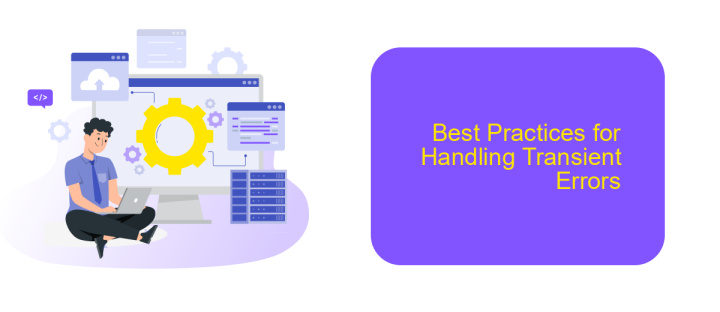What is Transient Error in Webmethods
In the realm of webMethods, a transient error is a temporary issue that disrupts the normal flow of processes but is typically resolved without manual intervention. These errors often arise from network instability, temporary unavailability of external services, or resource contention. Understanding and efficiently handling transient errors is crucial for maintaining robust and resilient integration solutions.
Introduction
In the realm of web services and integrations, transient errors are temporary issues that can disrupt the smooth functioning of applications. These errors are often unpredictable and can arise due to various reasons such as network instability, server overload, or temporary unavailability of external systems. Understanding and handling transient errors is crucial for maintaining the reliability and performance of web services, particularly in complex integration scenarios.
- Network instability causing temporary disconnections.
- Server overload leading to delayed responses.
- External system unavailability affecting data retrieval.
To mitigate the impact of transient errors, it's essential to implement robust error-handling mechanisms and retry strategies. Tools like ApiX-Drive can facilitate seamless integration by providing automated workflows and error-handling capabilities, ensuring that temporary disruptions do not affect the overall system performance. By leveraging such services, businesses can enhance the resilience of their web services and maintain uninterrupted operations.
Causes of Transient Errors

Transient errors in Webmethods can occur due to a variety of reasons. One common cause is network instability, which can disrupt the communication between systems and lead to temporary failures. Additionally, server overloads or resource constraints can also result in transient errors, as the system may not be able to handle the incoming requests efficiently. These issues are often temporary and can be resolved by retrying the operation after a short period.
Another cause of transient errors is related to external service dependencies. For instance, if your Webmethods integration relies on third-party APIs or services, any downtime or rate limiting on their end can cause transient errors. Utilizing integration services like ApiX-Drive can help mitigate these issues by providing robust error handling and retry mechanisms. ApiX-Drive offers seamless integration with various APIs, ensuring that your workflows remain resilient even in the face of transient errors. By leveraging such services, you can enhance the reliability and performance of your Webmethods integrations.
Impact of Transient Errors

Transient errors in Webmethods can significantly impact the performance and reliability of your integrations. These errors, which are temporary and often resolve themselves, can cause disruptions in data flow and lead to delays in processing. Understanding the impact of these errors is crucial for maintaining seamless operations.
- Data Delays: Transient errors can cause delays in data transfer between systems, affecting real-time data processing and decision-making.
- Increased Latency: The retry mechanisms to handle transient errors can introduce additional latency, slowing down the overall system performance.
- Resource Utilization: Handling transient errors often requires additional resources, such as CPU and memory, which can strain system capacity.
- Error Propagation: Unresolved transient errors can propagate through the system, causing cascading failures and further complicating troubleshooting efforts.
To mitigate the impact of transient errors, it's essential to implement robust error-handling mechanisms and consider using integration services like ApiX-Drive. ApiX-Drive offers advanced features to manage and automate integrations, helping to minimize disruptions caused by transient errors and ensuring smoother data flow across your systems.
Best Practices for Handling Transient Errors

Handling transient errors effectively is crucial for maintaining the reliability and performance of your integrations in Webmethods. Transient errors are temporary issues that can be resolved by retrying the failed operation after a short delay. Implementing best practices can help mitigate their impact and ensure seamless integration processes.
First, it's important to identify the types of transient errors that can occur in your system. These can include network timeouts, temporary unavailability of external services, or resource constraints. Understanding the common sources of these errors will help you develop strategies to handle them more effectively.
- Implement exponential backoff for retries to avoid overwhelming the system.
- Log transient errors separately to monitor their frequency and patterns.
- Use circuit breakers to prevent cascading failures in your integration workflows.
- Consider using ApiX-Drive to automate and manage your integration retries efficiently.
By following these best practices, you can ensure that your Webmethods integrations remain robust and resilient against transient errors. Regularly monitoring and updating your error-handling strategies will further enhance the stability and reliability of your integration processes.
Conclusion
In conclusion, understanding transient errors in Webmethods is crucial for maintaining the stability and reliability of your integration workflows. These temporary issues can arise from various factors such as network instability, server overload, or temporary unavailability of external systems. By identifying and implementing effective retry mechanisms, you can mitigate the impact of these errors on your processes.
Moreover, leveraging integration services like ApiX-Drive can further enhance your ability to manage and troubleshoot transient errors. ApiX-Drive offers robust tools for monitoring and automating retries, ensuring seamless data flow between systems. By incorporating such solutions, you can significantly reduce downtime and maintain the efficiency of your integrations, ultimately leading to improved operational performance and user satisfaction.


FAQ
What is a transient error in WebMethods?
How can transient errors be handled in WebMethods?
What are common causes of transient errors in WebMethods?
How can I minimize the impact of transient errors on my integration processes?
Is there a tool that can help with the automation and integration settings to handle transient errors?
Apix-Drive is a simple and efficient system connector that will help you automate routine tasks and optimize business processes. You can save time and money, direct these resources to more important purposes. Test ApiX-Drive and make sure that this tool will relieve your employees and after 5 minutes of settings your business will start working faster.

